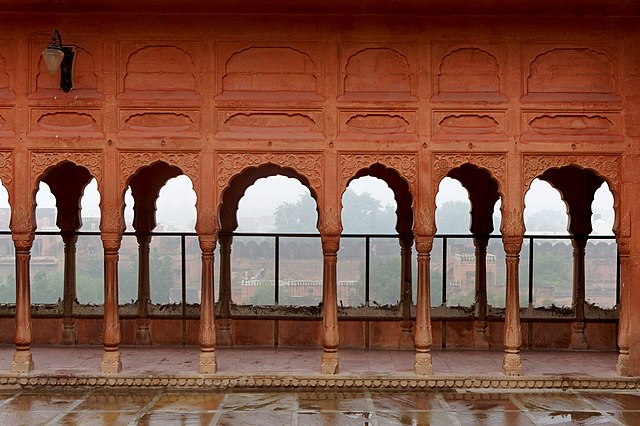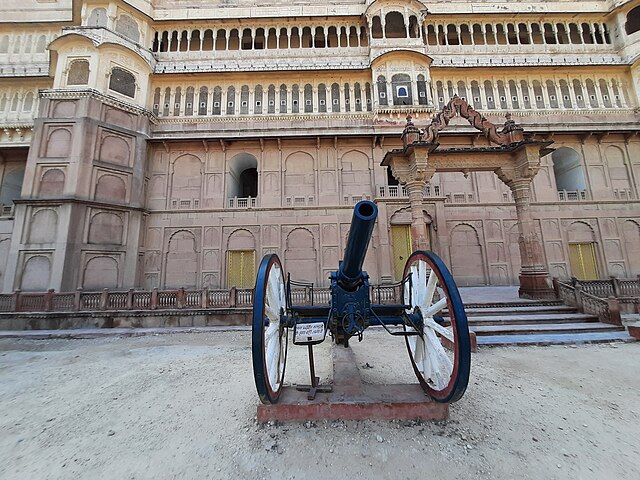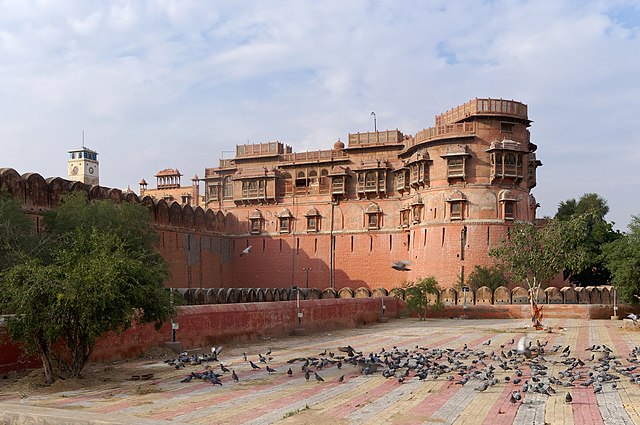Have you ever wondered what it feels like to step into a fairy tale? Junagarh Fort in Bikaner offers exactly that experience. While most travelers flock to Jaipur’s Amber Fort or Jodhpur’s Mehrangarh Fort, this magnificent fortress remains one of Rajasthan’s best-kept secrets. But here’s the thing – that’s exactly what makes it so special.
Imagine walking through corridors where maharajas once strolled, touching walls that have witnessed centuries of royal drama, and standing in courtyards where history literally comes alive. That’s the magic of Junagarh Fort, and today, we’re going to explore every inch of this architectural masterpiece together.
What Makes Junagarh Fort Special?
A Brief Introduction to the Unconquered Fort
Unlike many other forts in Rajasthan, Junagarh Fort has never been conquered. Think about that for a moment – in a land where empires rose and fell like desert storms, this fortress stood undefeated. Built in 1589 by Raja Rai Singh, one of Emperor Akbar’s most trusted generals, the fort represents an incredible fusion of military might and artistic brilliance.
The name “Junagarh” literally means “old fort,” but don’t let that fool you. This isn’t just another ancient structure collecting dust. It’s a living, breathing testament to Rajasthani resilience and creativity. The fort covers an area of 5.28 hectares and is surrounded by a 986-meter-long wall, making it one of the most impressive fortifications you’ll ever encounter.
Why Every Traveler Should Visit Junagarh Fort
What sets Junagarh Fort apart from its famous cousins? First, it’s remarkably well-preserved. While other forts have suffered from time and tourism, Junagarh maintains its original splendor. Second, it’s less crowded, which means you can actually enjoy the experience without fighting for photo opportunities.
But here’s the real kicker – the fort houses some of the most exquisite palaces in all of Rajasthan. We’re talking about rooms decorated with intricate mirror work, delicate glass paintings, and carvings so detailed they’ll make your jaw drop. It’s like discovering a treasure chest that everyone somehow forgot about.
The Rich History Behind Junagarh Fort
Raja Rai Singh and the Foundation Story
Picture this: It’s 1589, and Raja Rai Singh, fresh from his military campaigns with Emperor Akbar, decides to build a fort that would reflect both his military prowess and artistic sensibilities. Unlike other Rajasthani rulers who built their forts on hilltops, Rai Singh chose to construct his fortress on flat ground – a bold move that spoke to his confidence in its defensive capabilities.
Raja Rai Singh wasn’t just any ruler; he was a man who understood the importance of both war and peace. His fort reflects this philosophy perfectly. The exterior walls are imposing and military-focused, while the interior is a paradise of art and luxury. It’s like he created a fortress that could protect his people while providing them with beauty to inspire their souls.
The Evolution Through Different Rulers
What makes Junagarh Fort truly fascinating is how each successive ruler added their own touch to the complex. It’s like a collaborative artwork spanning centuries, where each artist contributed their unique vision while respecting what came before.
The Rathore rulers who followed Raja Rai Singh didn’t just maintain his creation – they enhanced it. Each generation added new palaces, courtyards, and decorative elements, creating a rich tapestry of architectural styles that tells the story of Bikaner’s evolution.
Contributions of Maharaja Ganga Singh
If Raja Rai Singh was the fort’s creator, Maharaja Ganga Singh was its greatest patron. Ruling from 1887 to 1943, he transformed Junagarh from a medieval fortress into a modern palace complex. Under his reign, the fort gained electricity, modern plumbing, and some of its most stunning decorative elements.
Ganga Singh was a visionary who understood that preserving tradition didn’t mean rejecting progress. His additions to the fort seamlessly blend traditional Rajasthani aesthetics with modern conveniences, creating spaces that were both historically authentic and practically livable.
Architectural Marvels That Will Leave You Speechless

Fusion of Rajput, Mughal, and Gujarati Styles
Here’s where Junagarh Fort gets really interesting. Instead of sticking to one architectural style, the builders created a unique fusion that draws from multiple traditions. You’ll see Rajput military architecture in the massive gates and walls, Mughal influence in the delicate arches and gardens, and Gujarati craftsmanship in the intricate stone work.
This architectural fusion isn’t random – it reflects the cosmopolitan nature of Bikaner’s court. The rulers were well-traveled, cultured individuals who appreciated beauty wherever they found it. Walking through the fort is like taking a masterclass in Indian architectural evolution.
Stunning Palaces Within the Fort Complex
The fort houses 37 palaces, each with its own personality and purpose. Some were designed for public ceremonies, others for private family life, and still others for specific seasons or occasions. It’s like a royal city within a city, where every building tells a different story.
What strikes you immediately is the attention to detail. These aren’t just grand spaces designed to impress – they’re carefully crafted environments meant to enhance daily life. The architects understood light, airflow, and acoustics in ways that modern builders are only beginning to appreciate.
Anup Mahal: The Jewel of the Fort
If you see only one palace within Junagarh Fort, make it Anup Mahal. This stunning structure represents the pinnacle of Rajasthani decorative arts. Every surface is covered with intricate gold leaf work, mirror inlay, and delicate paintings that seem to dance in the changing light.
The throne room within Anup Mahal is particularly breathtaking. Imagine sitting on a throne surrounded by walls that literally sparkle with embedded mirrors and gold. It’s not just about showing wealth – it’s about creating an environment that makes everyone who enters feel the weight and majesty of royal authority.
Chandra Mahal: Where Royalty Lived
While Anup Mahal was designed for ceremonies, Chandra Mahal was where the royal family actually lived. This palace offers intimate glimpses into royal daily life, with beautifully decorated bedrooms, private courtyards, and family gathering spaces.
What’s fascinating about Chandra Mahal is how it balances privacy with grandeur. The rooms are certainly luxurious, but they’re also human-scaled and livable. You can imagine children playing in the courtyards and families gathering for meals in the dining halls.
Must-See Attractions Inside Junagarh Fort
The Magnificent Durbar Hall
The Durbar Hall is where the magic of royal ceremony comes alive. This massive space was designed to accommodate hundreds of courtiers, visitors, and dignitaries during official functions. The acoustics are so perfect that a whisper from the throne can be heard clearly at the back of the hall.
What makes the Durbar Hall special isn’t just its size – it’s the way every detail contributes to an atmosphere of majesty and authority. The painted ceiling, the ornate columns, and the strategic placement of windows all work together to create a space where important decisions were made and royal justice was dispensed.
Royal Apartments and Their Stories
Each royal apartment tells a story about the person who lived there. The queen’s quarters are decorated with delicate floral motifs and feminine touches, while the king’s chambers emphasize strength and military themes. It’s like reading a series of architectural biographies.
These apartments also showcase the practical wisdom of Rajasthani architecture. Despite the desert location, the rooms remain cool during the day and warm at night. The builders understood how to work with the climate rather than against it, creating comfortable living spaces using only natural materials and clever design.
The Temple Complex
Within the fort walls, you’ll discover a beautiful temple complex that served the spiritual needs of the royal family and their retainers. These temples aren’t just religious spaces – they’re architectural gems that showcase the devotional side of royal life.
The temples feature some of the finest stone carving in the entire fort complex. Every pillar, every arch, and every decorative element has been crafted with the kind of attention to detail that modern craftsmen struggle to match. It’s a reminder that for these rulers, spiritual life was just as important as political power.
Planning Your Visit: Practical Information

Best Time to Visit Junagarh Fort
Timing your visit to Junagarh Fort can make or break your experience. The best months are October through March, when the desert heat is manageable and you can actually enjoy walking around the extensive complex. During these months, daytime temperatures hover around 25-30°C (77-86°F), perfect for exploration.
Avoid visiting during the summer months (April to September) unless you’re particularly heat-tolerant. Desert temperatures can soar above 45°C (113°F), making outdoor exploration uncomfortable and potentially dangerous. If you must visit during summer, plan to arrive early in the morning and leave by noon.
Entry Fees and Timings
The fort is open daily from 10:00 AM to 4:30 PM, giving you plenty of time to explore thoroughly. Entry fees are quite reasonable: ₹50 for Indian citizens and ₹200 for foreign tourists. There’s an additional camera fee of ₹50 if you want to photograph the interiors.
Here’s a pro tip: buy your tickets early in the day to avoid crowds. The fort tends to be less crowded in the morning hours, giving you better opportunities for photography and peaceful contemplation.
Photography Guidelines
While photography is allowed throughout most of the fort, there are some restrictions in certain areas. Flash photography is prohibited in rooms with delicate paintings or mirror work, as the bright light can cause damage over time. Some private family areas are also off-limits to cameras out of respect for the current royal family.
The best photography opportunities are in the courtyards and public halls, where natural light creates stunning effects on the decorated walls and ceilings. Golden hour (just before sunset) provides particularly magical lighting for exterior shots.
How to Reach Junagarh Fort Bikaner
Transportation Options
Getting to Junagarh Fort is easier than you might expect. Bikaner is well-connected by rail, road, and air to major Indian cities. The nearest airport is Bikaner Airport, though most visitors prefer to fly into Jaipur (330 km away) or Jodhpur (250 km away) and drive to Bikaner.
If you’re coming by train, Bikaner Junction is the main railway station, located just 2 km from the fort. From there, you can easily take an auto-rickshaw, taxi, or even walk if you’re feeling adventurous. The fort is located right in the heart of Bikaner city, making it accessible from anywhere in town.
Accommodation Near the Fort
Bikaner offers accommodation options for every budget, from luxury heritage hotels to budget guesthouses. For the full royal experience, consider staying at one of the heritage hotels that were once royal residences. These properties offer authentic Rajasthani hospitality and often include guided tours of the fort.
Budget travelers will find plenty of clean, comfortable guesthouses within walking distance of the fort. Many of these are family-run establishments that provide insider tips about the best times to visit and hidden spots worth exploring.
Tips for Making the Most of Your Visit
What to Wear and Bring
Comfortable walking shoes are essential – you’ll be doing a lot of walking on uneven stone surfaces. Dress modestly and respectfully, as this is both a historical monument and a place of cultural significance. Light, breathable fabrics work best in the desert climate.
Don’t forget to bring water, especially during warmer months. The fort complex is extensive, and dehydration can sneak up on you. A small backpack with water, snacks, and a portable charger for your camera will ensure you can explore comfortably for hours.
Guided Tours vs. Self-Exploration
This is a common dilemma for visitors. Guided tours provide valuable historical context and stories you might miss on your own. Local guides often share fascinating anecdotes about royal life and architectural details that aren’t mentioned in guidebooks.
However, self-exploration allows you to set your own pace and focus on what interests you most. Consider a compromise: take a guided tour for the main highlights, then return to explore your favorite areas more thoroughly on your own.
Conclusion
Junagarh Fort Bikaner isn’t just another tourist destination – it’s a journey through time that reveals the sophistication, artistry, and resilience of Rajasthani culture. From its unconquered walls to its breathtaking palaces, every element of this fortress tells a story worth hearing.
Whether you’re a history buff, architecture enthusiast, or simply someone who appreciates beauty, Junagarh Fort offers experiences that will stay with you long after you leave. It’s a reminder that sometimes the most rewarding discoveries are found off the beaten path, waiting patiently for those curious enough to seek them out.
So pack your bags, charge your camera, and prepare for an adventure that will change how you think about Indian heritage. Junagarh Fort is calling – will you answer?
FAQs
Q1: How much time should I allocate for visiting Junagarh Fort?
A: Plan for at least 3-4 hours to properly explore the main areas of Junagarh Fort. If you’re particularly interested in architecture and history, you could easily spend 5-6 hours discovering all the palaces, courtyards, and decorative details. The extensive complex rewards thorough exploration.
Q2: Is Junagarh Fort suitable for elderly visitors or those with mobility issues?
A: While the fort has many stairs and uneven surfaces typical of ancient architecture, the main courtyards and several key palaces are accessible with minimal climbing. However, reaching some upper levels and remote sections requires significant walking and stair climbing. Consider hiring a wheelchair or planning your route carefully.
Q3: Can I visit the royal family’s private quarters?
A: No, the current royal family of Bikaner still resides in parts of the fort complex, and their private areas are not open to tourists. However, the historical royal apartments that are open to visitors provide excellent insights into royal lifestyle and are extensively decorated and well-preserved.
Q4: What’s the difference between Junagarh Fort and other famous Rajasthani forts?
A: Unlike hilltop forts like Mehrangarh in Jodhpur or Amber Fort in Jaipur, Junagarh was built on flat ground and has never been conquered. It’s also remarkably well-preserved and less crowded, offering a more intimate experience with better opportunities to appreciate architectural details without fighting crowds.
Q5: Are there any festivals or special events held at Junagarh Fort?
A: Yes, the fort occasionally hosts cultural events, especially during Rajasthan’s tourism season (October to March). The annual Camel Festival in January sometimes includes events at the fort. Check with local tourism offices or the fort administration for current event schedules, as these can provide unique opportunities to see the fort in a festive, traditional context.

